Abstract
Amikacin was given to 14 noninfected men as three consecutive intramuscular injections (7.5 mg/kg) at 12-h intervals. Serum and bronchial secretion specimens were obtained at various times during flexible fiberoptic bronchoscopy after the final dose. Serum and bronchial secretion concentrations obtained between 1.5 and 2.0 h after the final dose ranged from 17 to 40 μg/ml and 2.3 to 8.4 μg/ml with a mean of 23.7 ± 2.9 and 5.23 ± 1.5 μg/ml, ±1 standard error of the mean, respectively. The highest bronchial secretion concentration in each subject correlated with the highest serum concentration (r = 0.83, P < 0.001), and all concurrent serum and bronchial secretion concentrations demonstrated a significant correlation (r = 0.82, P < 0.001). Clearance occurred at the same rate (half-life serum = 2.84 h; half-life of bronchial secretion = 2.60 h, P > 0.5). The mean bronchial secretion concentration of the 15 specimens obtained more than 7 h after the final dose was less than 1.0 μg/ml, with a range from 0.3 to 1.6 μg/ml. It is concluded that amikacin may achieve minimal inhibitory concentrations for many gram-negative bacteria in the bronchial secretions of noninfected patients 1 to 2 h after the final dose. However, levels fall below the reported minimal inhibitory concentrations against negative bacteria 6 to 7 h after the final dose. Furthermore, bronchial secretion levels may never reach the minimal inhibitory concentration against Pseudomonas aeruginosa.
Full text
PDF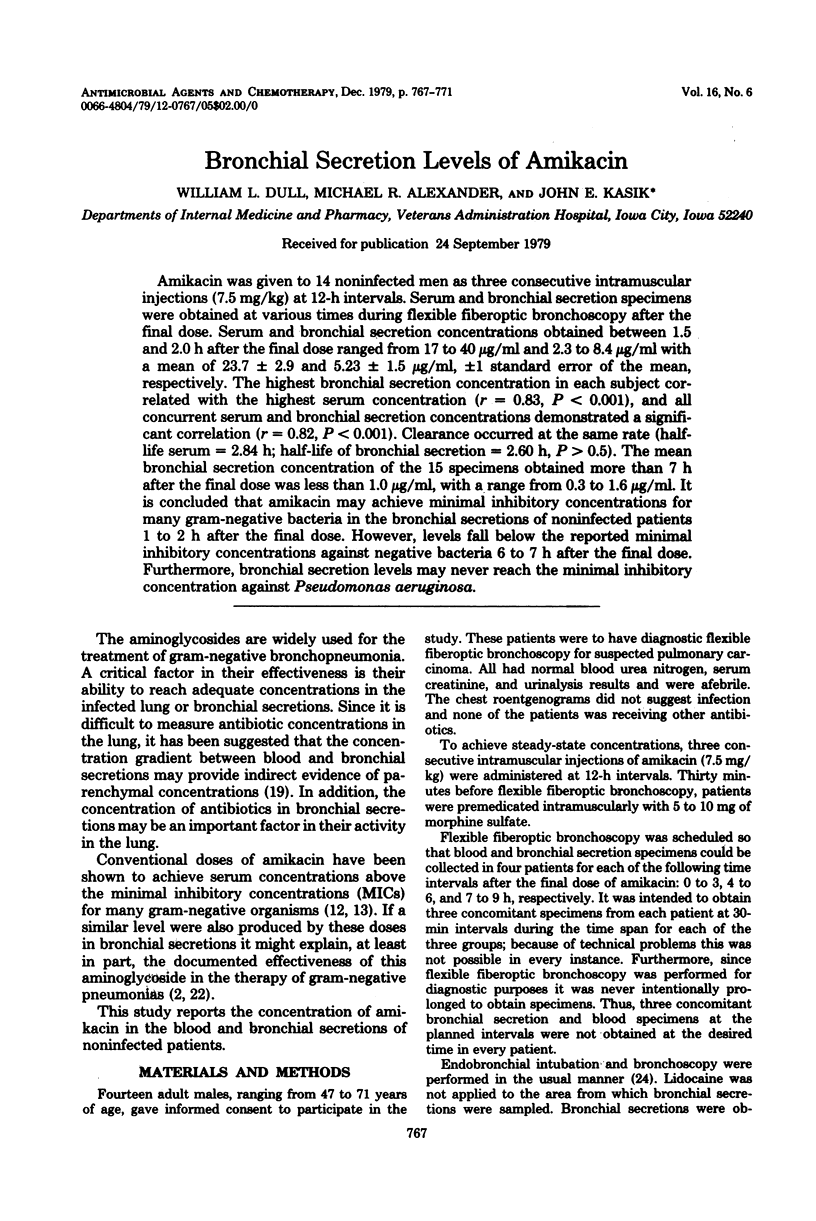
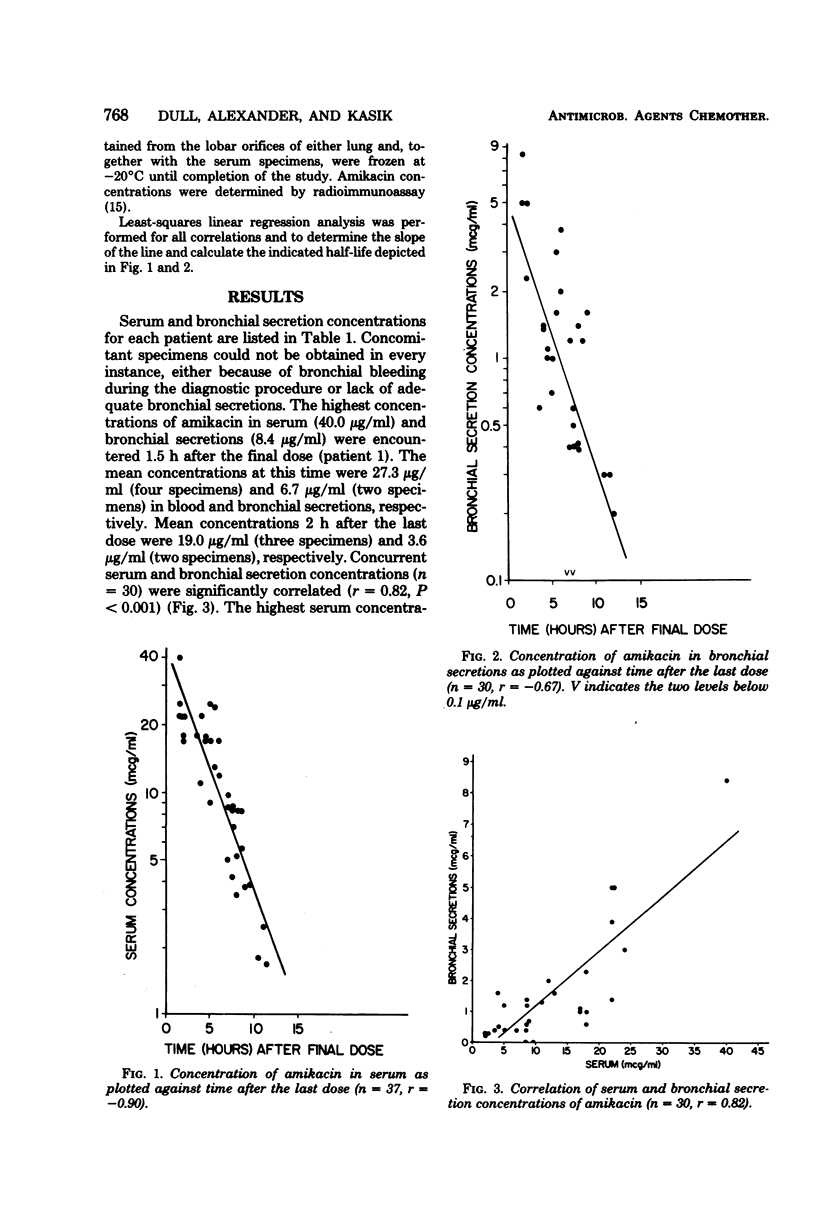
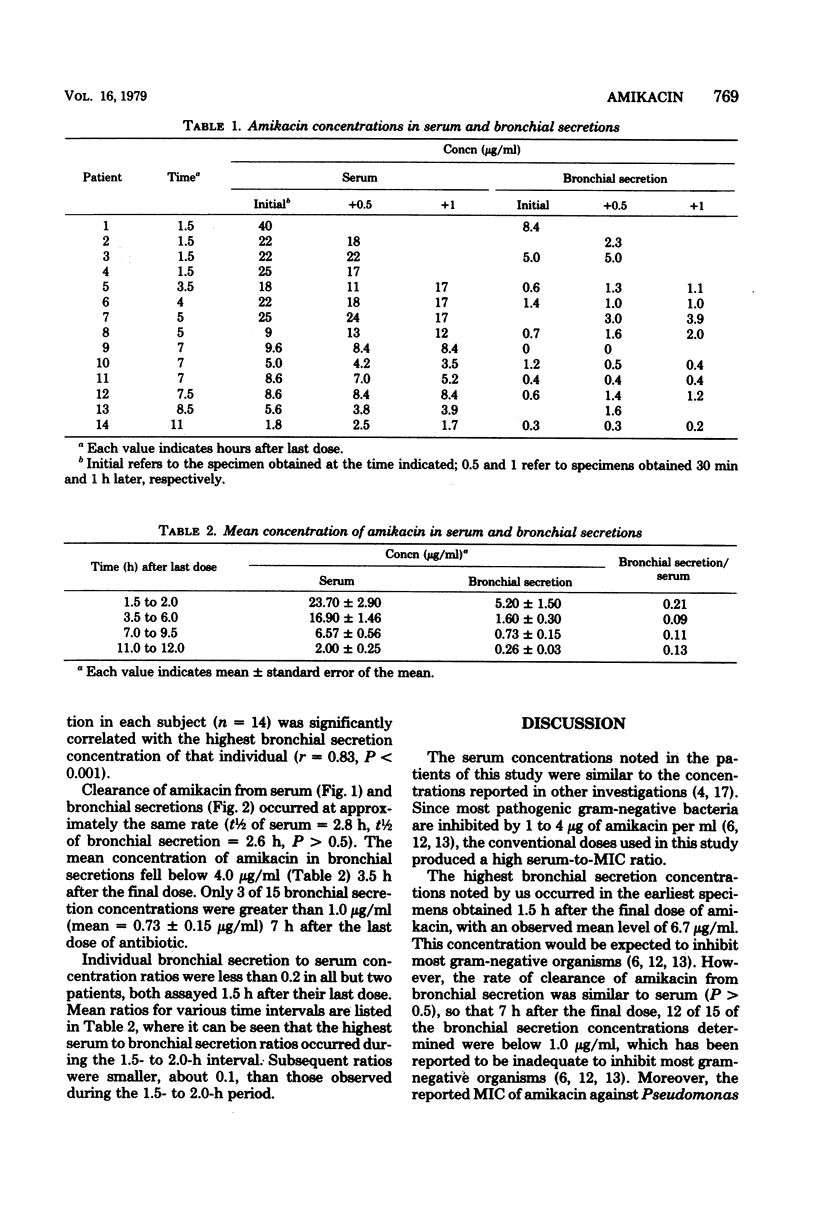
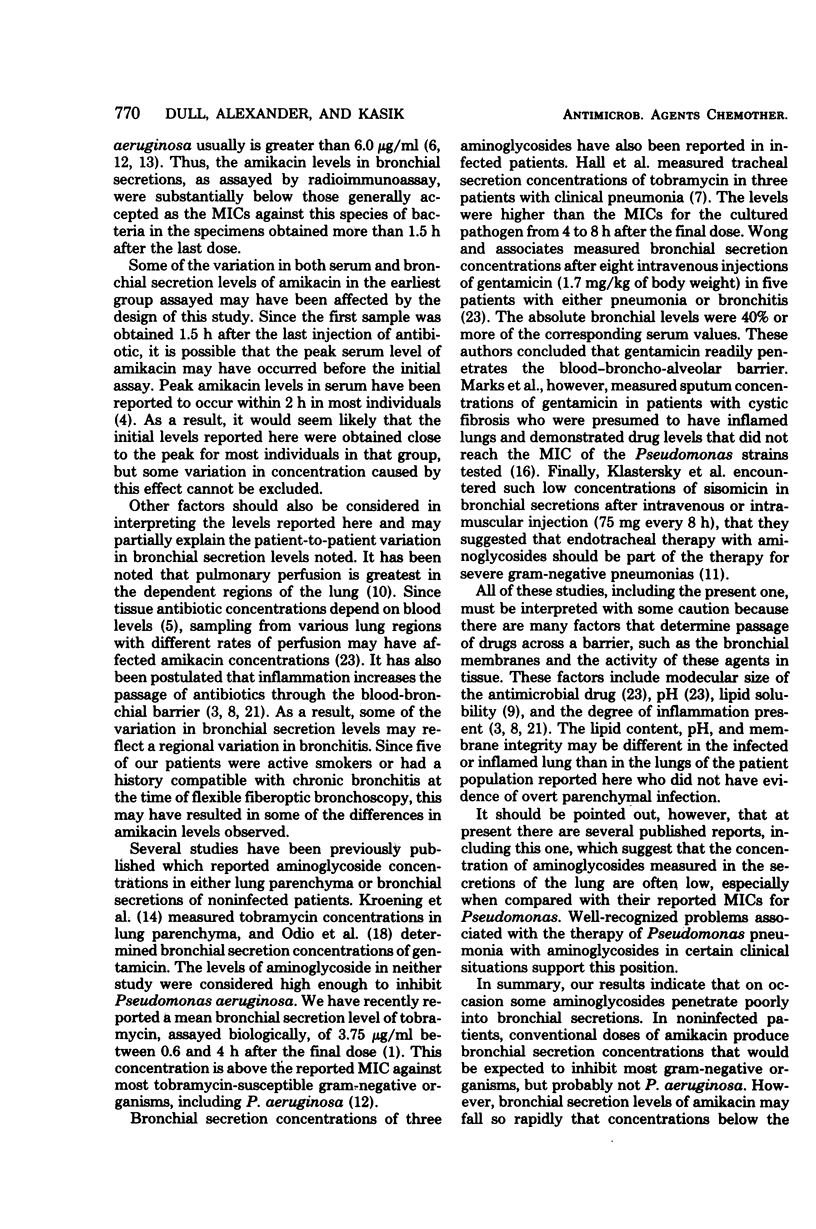
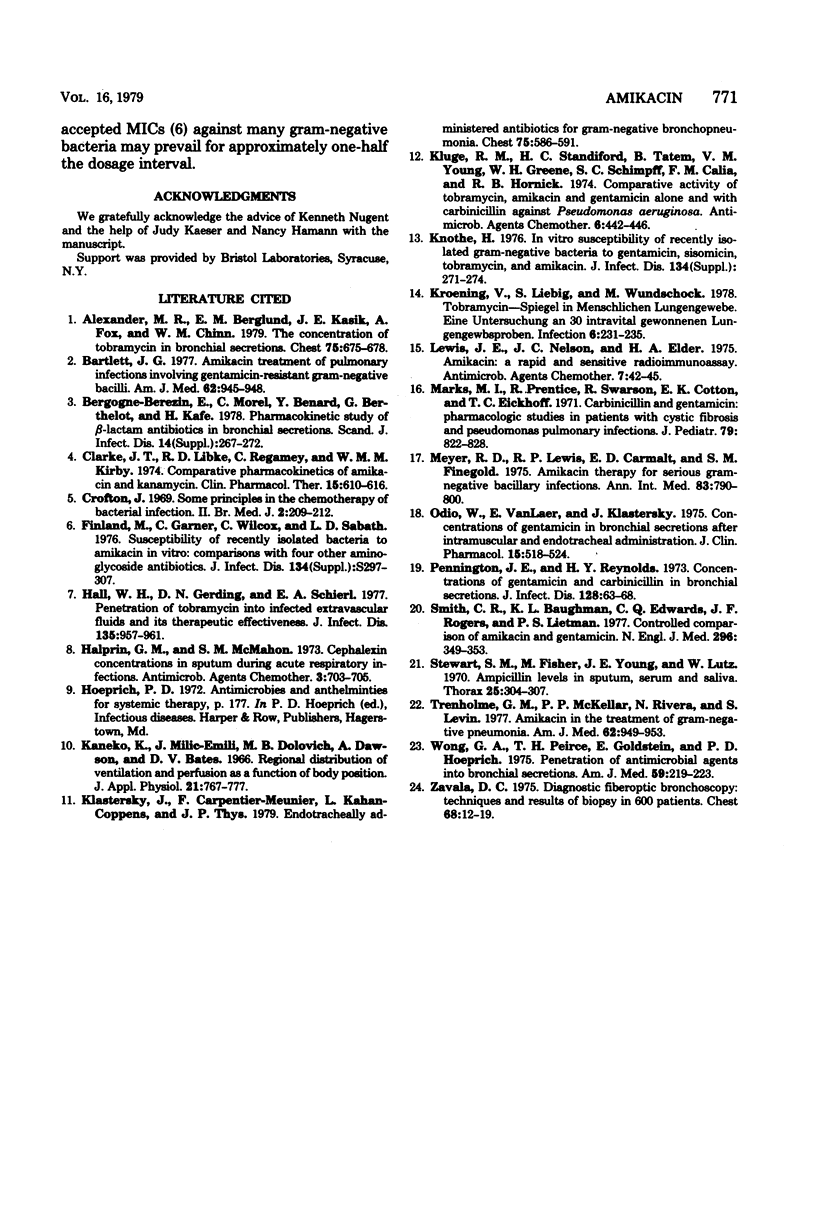
Selected References
These references are in PubMed. This may not be the complete list of references from this article.
- Alexander M. R., Berglund E. M., Kasik J. E., Fox A., Chinn W. M. The concentration of tobramycin in bronchial secretions. Chest. 1979 Jun;75(6):675–678. doi: 10.1378/chest.75.6.675. [DOI] [PubMed] [Google Scholar]
- Bartlett J. G. Amikacin treatment of pulmonary infections involving gentamicin-resistant gram-negative bacilli. Am J Med. 1977 Jun;62(6):945–948. doi: 10.1016/0002-9343(77)90666-0. [DOI] [PubMed] [Google Scholar]
- Bergogne-Berezin E., Morel C., Benard Y., Berthelot G., Kafe H. Pharmacokinetic study of beta-lactam antibiotics in bronchial secretions. Scand J Infect Dis Suppl. 1978;(14):267–272. [PubMed] [Google Scholar]
- Clarke J. T., Libke R. D., Regamey C., Kirby W. M. Comparative pharmacokinetics of amikacin and kanamycin. Clin Pharmacol Ther. 1974 Jun;15(6):610–616. doi: 10.1002/cpt1974156610. [DOI] [PubMed] [Google Scholar]
- Crofton J. Some principles in the chemotherapy of bacterial infections. II. Br Med J. 1969 Apr 26;2(5651):209–212. doi: 10.1136/bmj.2.5651.209. [DOI] [PMC free article] [PubMed] [Google Scholar]
- Finland M., Garner C., Wilcox C., Sabath L. D. Susceptibility of recently isolated bacteria to amikacin in vitro: comparisons with four other aminoglycoside antibiotics. J Infect Dis. 1976 Nov;134(Suppl):S297–S307. doi: 10.1093/infdis/135.supplement_2.s297. [DOI] [PubMed] [Google Scholar]
- Hall W. H., Gerding D. N., Schierl E. A. Penetration of tobramycin into infected extravascular fluids and its therapeutic effectiveness. J Infect Dis. 1977 Jun;135(6):957–961. doi: 10.1093/infdis/135.6.957. [DOI] [PubMed] [Google Scholar]
- Halprin G. M., McMahon S. M. Cephalexin concentrations in sputum during acute respiratory infections. Antimicrob Agents Chemother. 1973 Jun;3(6):703–707. doi: 10.1128/aac.3.6.703. [DOI] [PMC free article] [PubMed] [Google Scholar]
- Kaneko K., Milic-Emili J., Dolovich M. B., Dawson A., Bates D. V. Regional distribution of ventilation and perfusion as a function of body position. J Appl Physiol. 1966 May;21(3):767–777. doi: 10.1152/jappl.1966.21.3.767. [DOI] [PubMed] [Google Scholar]
- Klastersky J., Carpentier-Meunier F., Kahan-Coppens L., Thys J. P. Endotracheally administered antibiotics for gram-negative bronchopneumonia. Chest. 1979 May;75(5):586–591. doi: 10.1378/chest.75.5.586. [DOI] [PubMed] [Google Scholar]
- Klastersky J., Meunier-Carpentier F., Prevost J. M., Staquet M. Synergism between amikacin and cefazolin against Klebsiella: in vitro studies and effect on the bactericidal activity of serum. J Infect Dis. 1976 Sep;134(3):271–276. doi: 10.1093/infdis/134.3.271. [DOI] [PubMed] [Google Scholar]
- Kluge R. M., Standiford H. C., Tatem B., Young V. M., Greene W. H., Schimpff S. C., Calia F. M., Hornick R. B. Comparative activity of tobramycin, amikacin, and gentamicin alone and with carbenicillin against Pseudomonas aeruginosa. Antimicrob Agents Chemother. 1974 Oct;6(4):442–446. doi: 10.1128/aac.6.4.442. [DOI] [PMC free article] [PubMed] [Google Scholar]
- Kroening U., Liebig S., Wundschock M. Tobramycin-Spiegel im menschlichen Lungengewebe. Infection. 1978;6(5):231–235. doi: 10.1007/BF01642315. [DOI] [PubMed] [Google Scholar]
- Lewis J. E., Nelson J. C., Elder H. A. Amikacin: a rapid and sensitive radioimmunoassay. Antimicrob Agents Chemother. 1975 Jan;7(1):42–45. doi: 10.1128/aac.7.1.42. [DOI] [PMC free article] [PubMed] [Google Scholar]
- Marks M. I., Prentice R., Swarson R., Cotton E. K., Eickhoff T. C. Carbenicillin and gentamicin: pharmacologic studies in patients with cystic fibrosis and pseudomonas pulmonary infections. J Pediatr. 1971 Nov;79(5):822–828. doi: 10.1016/s0022-3476(71)80401-8. [DOI] [PubMed] [Google Scholar]
- Meyer R. D., Lewis R. P., Carmalt E. D., Finegold S. M. Amikacin therapy for serious gram-negative bacillary infections. Ann Intern Med. 1975 Dec;83(6):790–800. doi: 10.7326/0003-4819-83-6-790. [DOI] [PubMed] [Google Scholar]
- Odio W., Van Laer E., Klastersky J. Concentrations of gentamicin in bronchial secretions after intramuscular and endotracheal administration. J Clin Pharmacol. 1975 Jul;15(7):518–524. doi: 10.1002/j.1552-4604.1975.tb01474.x. [DOI] [PubMed] [Google Scholar]
- Pennington J. E., Reynolds H. Y. Concentrations of gentamicin and carbenicillin in bronchial secretions. J Infect Dis. 1973 Jul;128(1):63–68. doi: 10.1093/infdis/128.1.63. [DOI] [PubMed] [Google Scholar]
- Smith C. R., Baughman K. L., Edwards C. Q., Rogers J. F., Lietman P. S. Controlled comparison of amikacin and gentamicin. N Engl J Med. 1977 Feb 17;296(7):349–353. doi: 10.1056/NEJM197702172960701. [DOI] [PubMed] [Google Scholar]
- Stewart S. M., Fisher M., Young J. E., Lutz W. Ampicillin levels in sputum, serum, and saliva. Thorax. 1970 May;25(3):304–311. doi: 10.1136/thx.25.3.304. [DOI] [PMC free article] [PubMed] [Google Scholar]
- Trenholme G. M., McKellar P. P., Rivera N., Levin S. Amikacin in the treatment of gram-negative pneumonia. Am J Med. 1977 Jun;62(6):949–953. doi: 10.1016/0002-9343(77)90667-2. [DOI] [PubMed] [Google Scholar]
- Wong G. A., Pierce T. H., Goldstein E., Hoeprich P. D. Penetration of antimicrobial agents into bronchial secretions. Am J Med. 1975 Aug;59(2):219–223. doi: 10.1016/0002-9343(75)90356-3. [DOI] [PubMed] [Google Scholar]
- Zavala D. C. Diagnostic fiberoptic bronchoscopy: Techniques and results of biopsy in 600 patients. Chest. 1975 Jul;68(1):12–19. doi: 10.1378/chest.68.1.12. [DOI] [PubMed] [Google Scholar]


